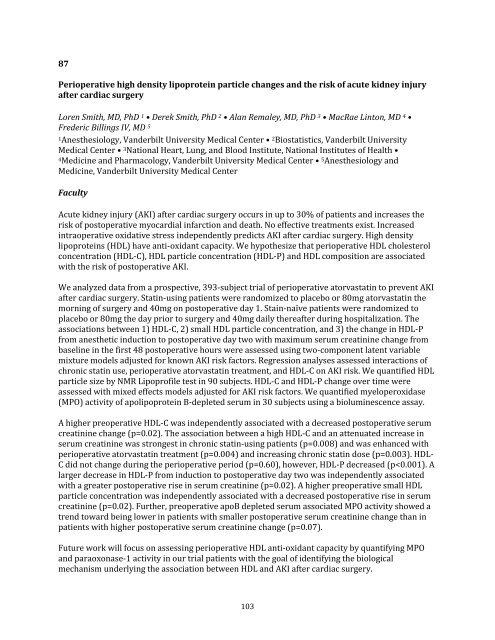2017 Cardiovascular Research Day Abstract Book
Create successful ePaper yourself
Turn your PDF publications into a flip-book with our unique Google optimized e-Paper software.
87<br />
Perioperative high density lipoprotein particle changes and the risk of acute kidney injury<br />
after cardiac surgery<br />
Loren Smith, MD, PhD 1 • Derek Smith, PhD 2 • Alan Remaley, MD, PhD 3 • MacRae Linton, MD 4 •<br />
Frederic Billings IV, MD 5<br />
1Anesthesiology, Vanderbilt University Medical Center • 2 Biostatistics, Vanderbilt University<br />
Medical Center • 3 National Heart, Lung, and Blood Institute, National Institutes of Health •<br />
4Medicine and Pharmacology, Vanderbilt University Medical Center • 5 Anesthesiology and<br />
Medicine, Vanderbilt University Medical Center<br />
Faculty<br />
Acute kidney injury (AKI) after cardiac surgery occurs in up to 30% of patients and increases the<br />
risk of postoperative myocardial infarction and death. No effective treatments exist. Increased<br />
intraoperative oxidative stress independently predicts AKI after cardiac surgery. High density<br />
lipoproteins (HDL) have anti-oxidant capacity. We hypothesize that perioperative HDL cholesterol<br />
concentration (HDL-C), HDL particle concentration (HDL-P) and HDL composition are associated<br />
with the risk of postoperative AKI.<br />
We analyzed data from a prospective, 393-subject trial of perioperative atorvastatin to prevent AKI<br />
after cardiac surgery. Statin-using patients were randomized to placebo or 80mg atorvastatin the<br />
morning of surgery and 40mg on postoperative day 1. Stain-naïve patients were randomized to<br />
placebo or 80mg the day prior to surgery and 40mg daily thereafter during hospitalization. The<br />
associations between 1) HDL-C, 2) small HDL particle concentration, and 3) the change in HDL-P<br />
from anesthetic induction to postoperative day two with maximum serum creatinine change from<br />
baseline in the first 48 postoperative hours were assessed using two-component latent variable<br />
mixture models adjusted for known AKI risk factors. Regression analyses assessed interactions of<br />
chronic statin use, perioperative atorvastatin treatment, and HDL-C on AKI risk. We quantified HDL<br />
particle size by NMR Lipoprofile test in 90 subjects. HDL-C and HDL-P change over time were<br />
assessed with mixed effects models adjusted for AKI risk factors. We quantified myeloperoxidase<br />
(MPO) activity of apolipoprotein B-depleted serum in 30 subjects using a bioluminescence assay.<br />
A higher preoperative HDL-C was independently associated with a decreased postoperative serum<br />
creatinine change (p=0.02). The association between a high HDL-C and an attenuated increase in<br />
serum creatinine was strongest in chronic statin-using patients (p=0.008) and was enhanced with<br />
perioperative atorvastatin treatment (p=0.004) and increasing chronic statin dose (p=0.003). HDL-<br />
C did not change during the perioperative period (p=0.60), however, HDL-P decreased (p


